- Troughs: Hanging troughs are a practical solution for balconies and terraces. They can be fixed to vertical supports or hung from hooks, allowing cucumbers to trail elegantly over the sides.
- Baskets: Hanging baskets provide not only support for climbing plants but also a decorative touch. Choose baskets large enough to accommodate cucumber growth and ensure good drainage.
- Buckets: Using hanging buckets is a clever method to grow cucumbers vertically. They are perfect for limited spaces and can be easily attached to existing structures.
DIY structures: pallets, PVC pipes
- Pallets: Reclaimed wooden pallets can be transformed into economical, eco-friendly vertical trellises. They offer ample space for cucumbers to climb and can be customised to fit available space.
- PVC pipes: PVC pipes, often used for irrigation systems, can also be used to create support structures for cucumbers. They are lightweight, weather-resistant and can be assembled in various configurations.
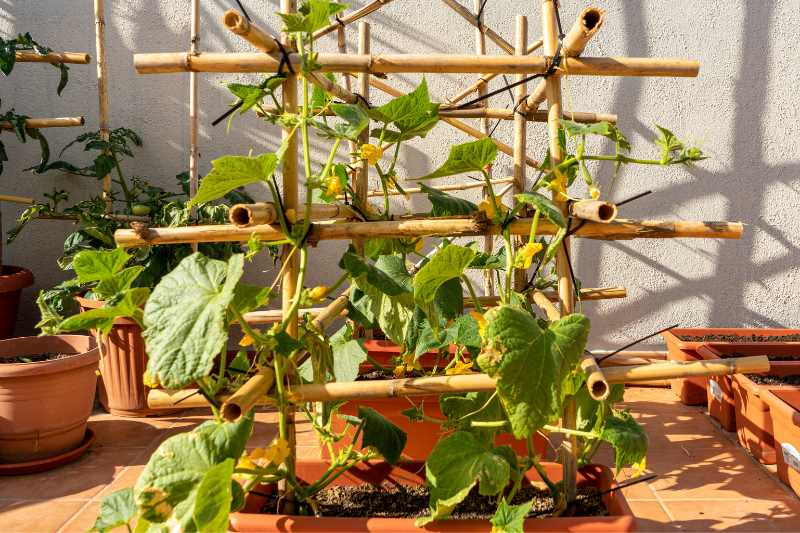
Installation and training
Installation and training are crucial steps in successful vertical cucumber growing. Here’s how to proceed to ensure healthy growth and an abundant harvest:
- Secure the support firmly: Before planting, make sure the chosen support is well anchored in the soil or firmly fixed to an existing structure. This will prevent the support from tipping or collapsing under the weight of plants and fruit. For trellises or wire mesh, use stakes or anchors suited to the soil type. For hanging structures, check the strength of hooks and fastenings.
- Position cucumber plants close to the support: Cucumber plants should be placed to ease their access to the support. Generally, this means planting them directly at the base of the trellis or chosen support. Leave enough space between plants to allow good air circulation and facilitate growth, following variety-specific recommendations.
- Guide stems to the support as they grow: Early on, you may need to help young stems attach to the support. Use soft ties, such as raffia or special plant ties, to gently secure stems to the support without damaging them. Take care not to tie too tightly so as not to hinder sap circulation.
- Regular training for better sun exposure: As plants grow, continue to guide and tie them to the support to optimise sun exposure and maintain good ventilation between leaves and fruit. Regular training also allows you to check plant health and intervene quickly in case of disease or pest infestation.
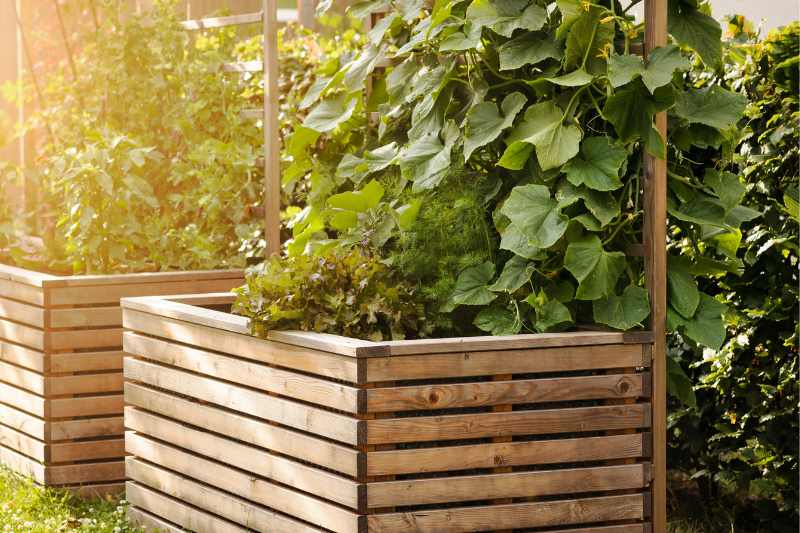
Brief summary about cucumber growing
- Sowing date: Cucumber sowing is usually done indoors, under cover, about 3 to 4 weeks before the last expected frost. Outdoors, wait until soil is well warmed and no risk of frost remains, often May or June depending on climate.
- Growing under cover or outdoors: Growing under cover (greenhouse or polytunnel) can start earlier in the season, offering protection from cold temperatures and extending harvest period. Outdoor growing suits warmer regions or after last frosts.
- Growth conditions: Cucumbers need a sunny position, fertile soil rich in organic matter and good drainage. Regular watering, especially during dry periods, is essential to maintain steady growth.
- Harvest time: Harvest usually begins 50 to 70 days after sowing, depending on variety. Cucumbers are picked when they reach desired size, often before they become too large and seeds harden, which affects quality.
Cucumber or gherkin? The cucumber and the gherkin come from plants of the same family, but they are not identical and do not represent the same fruit at different stages of ripeness, as is often thought. Their main difference lies in varieties grown specifically for distinct uses (although some cucumber varieties can be harvested young and prepared much like gherkins).
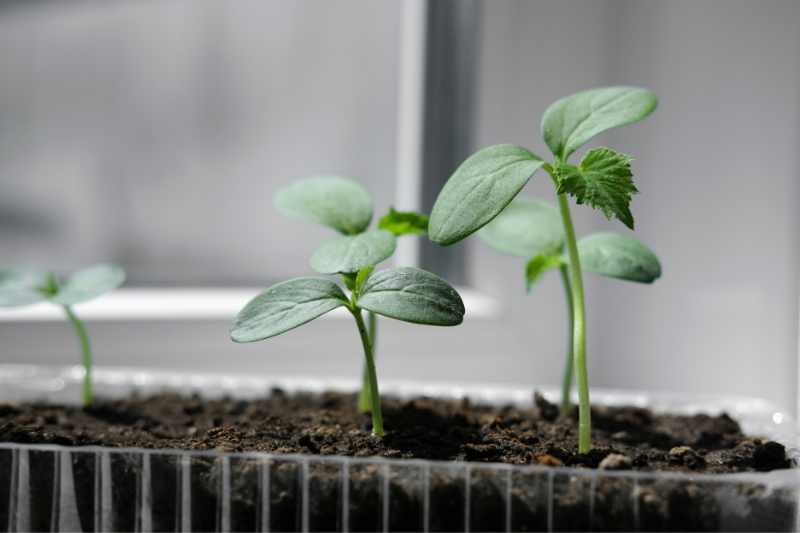
Care and maintenance
- Regular watering, especially in summer: Cucumbers need soil that is consistently moist but not waterlogged. Water them frequently, particularly during hot periods, to avoid water stress that can affect growth and fruit production.
- Balanced fertilisation to encourage growth: Apply a balanced fertiliser rich in potassium and nitrogen at the start of the growing season to stimulate leaf and fruit development. Additional feeding may be needed during the season to support abundant production.
- Mulching to retain soil moisture: Mulching helps conserve soil moisture, reduces weed growth and keeps soil temperature stable. Use organic mulch, such as straw or wood chips, around plants.
- Monitor pests and diseases: Inspect cucumbers regularly for signs of pests (such as aphids or mites) or diseases (such as powdery mildew or rust). Intervene quickly with appropriate treatments, favouring organic options to maintain a healthy garden environment.
To learn more about cucumber cultivation, read Cucumber and gherkin: sowing, planting, cultivation, pruning and harvest.
Harvesting cucumbers: It is generally recommended to pick cucumbers before they become too large and seeds harden, which can affect texture and flavour. After harvesting, to prolong freshness place cucumbers in a perforated plastic bag and store in the fridge.
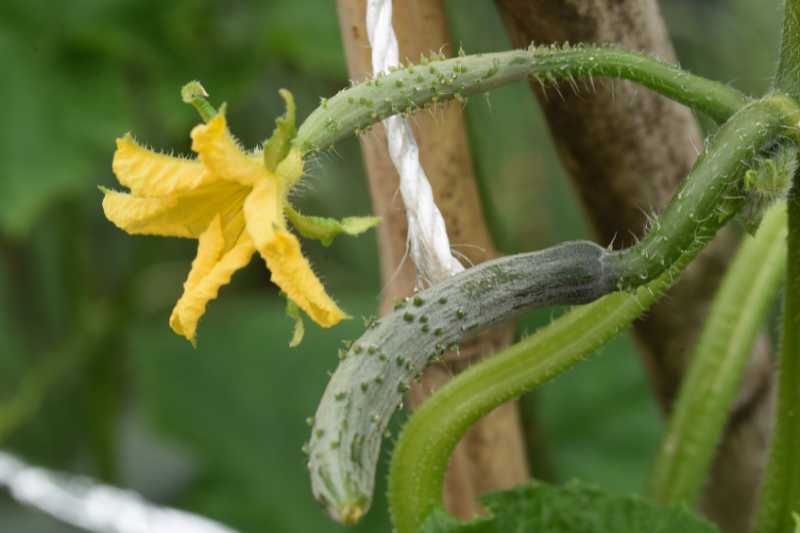
Final tips for successful cucumber growing
- Choose a sunny location sheltered from wind: Cucumbers thrive in warm, sunny conditions. A site receiving at least 6 to 8 hours of direct sun per day is ideal. Shelter from wind is crucial to prevent physical damage to plants and support.
- Use fertile, well-drained soil: Soil rich in organic matter and well drained promotes healthy root growth and good nutrient availability. Adding compost can improve soil structure and fertility.
- Water in the morning to avoid evaporation: Morning watering allows water to penetrate deeply into soil, reaching roots while minimising evaporation. It also helps leaves dry quickly, reducing risk of fungal disease.
- Monitor water and nutrient needs: Cucumbers are heavy feeders of water and nutrients, especially during periods of vigorous growth and fruit development. Consistently moist soil and regular feeding with a balanced fertiliser will support abundant production.
- Prune secondary branches to focus growth on fruit: Pruning directs plant energy towards fruit production rather than excessive leaf growth. Remove secondary branches and unnecessary side shoots to encourage larger, better-quality cucumbers.
Save space and maximise your harvests by growing your cucumbers vertically! This complete guide explains everything you need to know to succeed with this method, from selecting varieties to harvesting fruit.
Discover the advantages of vertical growing, the different techniques available and the best practices to produce tasty, healthy cucumbers.
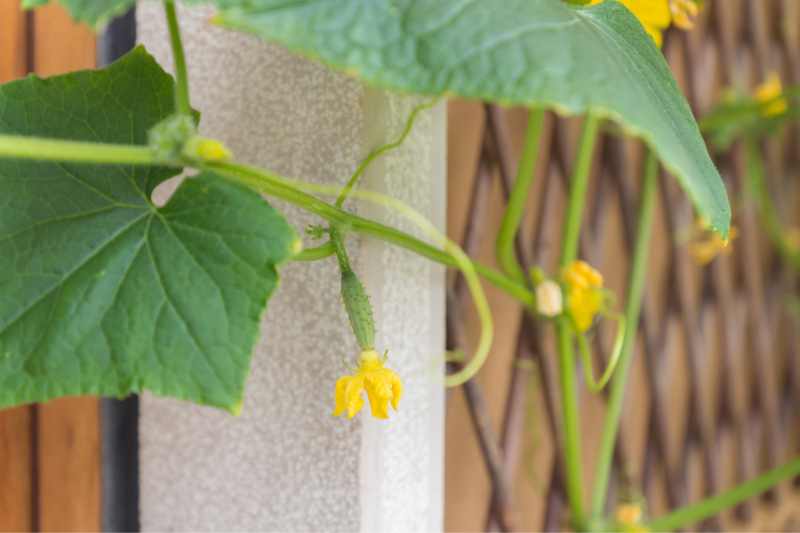
Why grow vertically?
Vertical growing of cucumbers offers several significant advantages:
- Save space: ideal for small gardens, balconies and terraces.
- Better air circulation: reduces risk of disease and parasitic pests.
- Easier harvesting: cucumbers are within easy reach.
- Aesthetic: this type of growing adds a decorative touch to your vegetable patch.
Which support to choose?
Choosing the right support for vertical cucumber growing is essential to ensure healthy growth and an abundant harvest. Options range from ready-to-use solutions to homemade structures, offering flexibility to meet different needs and aesthetic preferences.
Support: Trellis, filament, wire mesh
- Trellis: Trellises are among the most popular supports for vertical growing. They can be made of wood, metal or plastic and provide a wide surface for plants to climb. A trellis allows excellent air circulation and makes harvesting cucumbers easier.
- Filament: Filaments are a lightweight, low-cost option, ideal for gardeners on a budget. Easy to install between posts or along a wall, they provide good support for cucumbers while taking up very little space.
- Wire mesh: Metal wire mesh, such as that used for fences, is robust and can support the weight of several cucumber plants. It is particularly suitable for large installations and can be reused year after year.
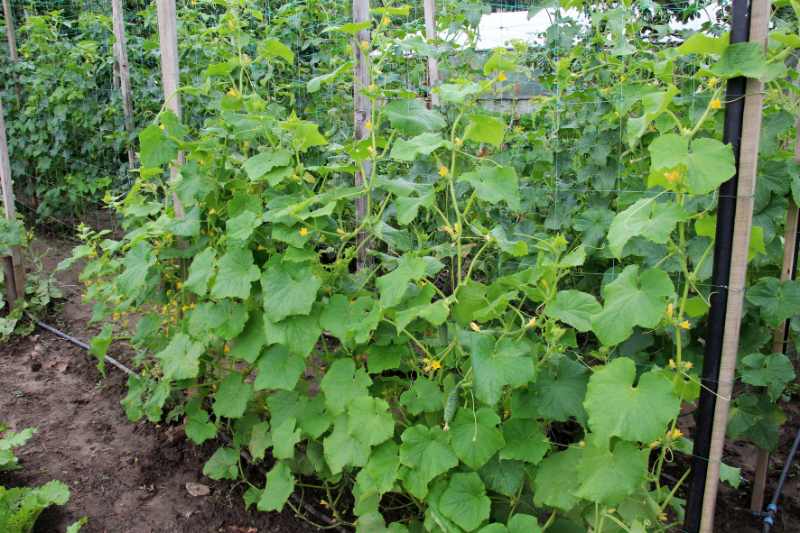
Hanging containers: troughs, baskets, buckets
- Troughs: Hanging troughs are a practical solution for balconies and terraces. They can be fixed to vertical supports or hung from hooks, allowing cucumbers to trail elegantly over the sides.
- Baskets: Hanging baskets provide not only support for climbing plants but also a decorative touch. Choose baskets large enough to accommodate cucumber growth and ensure good drainage.
- Buckets: Using hanging buckets is a clever method to grow cucumbers vertically. They are perfect for limited spaces and can be easily attached to existing structures.
DIY structures: pallets, PVC pipes
- Pallets: Reclaimed wooden pallets can be transformed into economical, eco-friendly vertical trellises. They offer ample space for cucumbers to climb and can be customised to fit available space.
- PVC pipes: PVC pipes, often used for irrigation systems, can also be used to create support structures for cucumbers. They are lightweight, weather-resistant and can be assembled in various configurations.

Installation and training
Installation and training are crucial steps in successful vertical cucumber growing. Here’s how to proceed to ensure healthy growth and an abundant harvest:
- Secure the support firmly: Before planting, make sure the chosen support is well anchored in the soil or firmly fixed to an existing structure. This will prevent the support from tipping or collapsing under the weight of plants and fruit. For trellises or wire mesh, use stakes or anchors suited to the soil type. For hanging structures, check the strength of hooks and fastenings.
- Position cucumber plants close to the support: Cucumber plants should be placed to ease their access to the support. Generally, this means planting them directly at the base of the trellis or chosen support. Leave enough space between plants to allow good air circulation and facilitate growth, following variety-specific recommendations.
- Guide stems to the support as they grow: Early on, you may need to help young stems attach to the support. Use soft ties, such as raffia or special plant ties, to gently secure stems to the support without damaging them. Take care not to tie too tightly so as not to hinder sap circulation.
- Regular training for better sun exposure: As plants grow, continue to guide and tie them to the support to optimise sun exposure and maintain good ventilation between leaves and fruit. Regular training also allows you to check plant health and intervene quickly in case of disease or pest infestation.

Brief summary about cucumber growing
- Sowing date: Cucumber sowing is usually done indoors, under cover, about 3 to 4 weeks before the last expected frost. Outdoors, wait until soil is well warmed and no risk of frost remains, often May or June depending on climate.
- Growing under cover or outdoors: Growing under cover (greenhouse or polytunnel) can start earlier in the season, offering protection from cold temperatures and extending harvest period. Outdoor growing suits warmer regions or after last frosts.
- Growth conditions: Cucumbers need a sunny position, fertile soil rich in organic matter and good drainage. Regular watering, especially during dry periods, is essential to maintain steady growth.
- Harvest time: Harvest usually begins 50 to 70 days after sowing, depending on variety. Cucumbers are picked when they reach desired size, often before they become too large and seeds harden, which affects quality.
Cucumber or gherkin? The cucumber and the gherkin come from plants of the same family, but they are not identical and do not represent the same fruit at different stages of ripeness, as is often thought. Their main difference lies in varieties grown specifically for distinct uses (although some cucumber varieties can be harvested young and prepared much like gherkins).

Care and maintenance
- Regular watering, especially in summer: Cucumbers need soil that is consistently moist but not waterlogged. Water them frequently, particularly during hot periods, to avoid water stress that can affect growth and fruit production.
- Balanced fertilisation to encourage growth: Apply a balanced fertiliser rich in potassium and nitrogen at the start of the growing season to stimulate leaf and fruit development. Additional feeding may be needed during the season to support abundant production.
- Mulching to retain soil moisture: Mulching helps conserve soil moisture, reduces weed growth and keeps soil temperature stable. Use organic mulch, such as straw or wood chips, around plants.
- Monitor pests and diseases: Inspect cucumbers regularly for signs of pests (such as aphids or mites) or diseases (such as powdery mildew or rust). Intervene quickly with appropriate treatments, favouring organic options to maintain a healthy garden environment.
To learn more about cucumber cultivation, read Cucumber and gherkin: sowing, planting, cultivation, pruning and harvest.
Harvesting cucumbers: It is generally recommended to pick cucumbers before they become too large and seeds harden, which can affect texture and flavour. After harvesting, to prolong freshness place cucumbers in a perforated plastic bag and store in the fridge.

Final tips for successful cucumber growing
- Choose a sunny location sheltered from wind: Cucumbers thrive in warm, sunny conditions. A site receiving at least 6 to 8 hours of direct sun per day is ideal. Shelter from wind is crucial to prevent physical damage to plants and support.
- Use fertile, well-drained soil: Soil rich in organic matter and well drained promotes healthy root growth and good nutrient availability. Adding compost can improve soil structure and fertility.
- Water in the morning to avoid evaporation: Morning watering allows water to penetrate deeply into soil, reaching roots while minimising evaporation. It also helps leaves dry quickly, reducing risk of fungal disease.
- Monitor water and nutrient needs: Cucumbers are heavy feeders of water and nutrients, especially during periods of vigorous growth and fruit development. Consistently moist soil and regular feeding with a balanced fertiliser will support abundant production.
- Prune secondary branches to focus growth on fruit: Pruning directs plant energy towards fruit production rather than excessive leaf growth. Remove secondary branches and unnecessary side shoots to encourage larger, better-quality cucumbers.































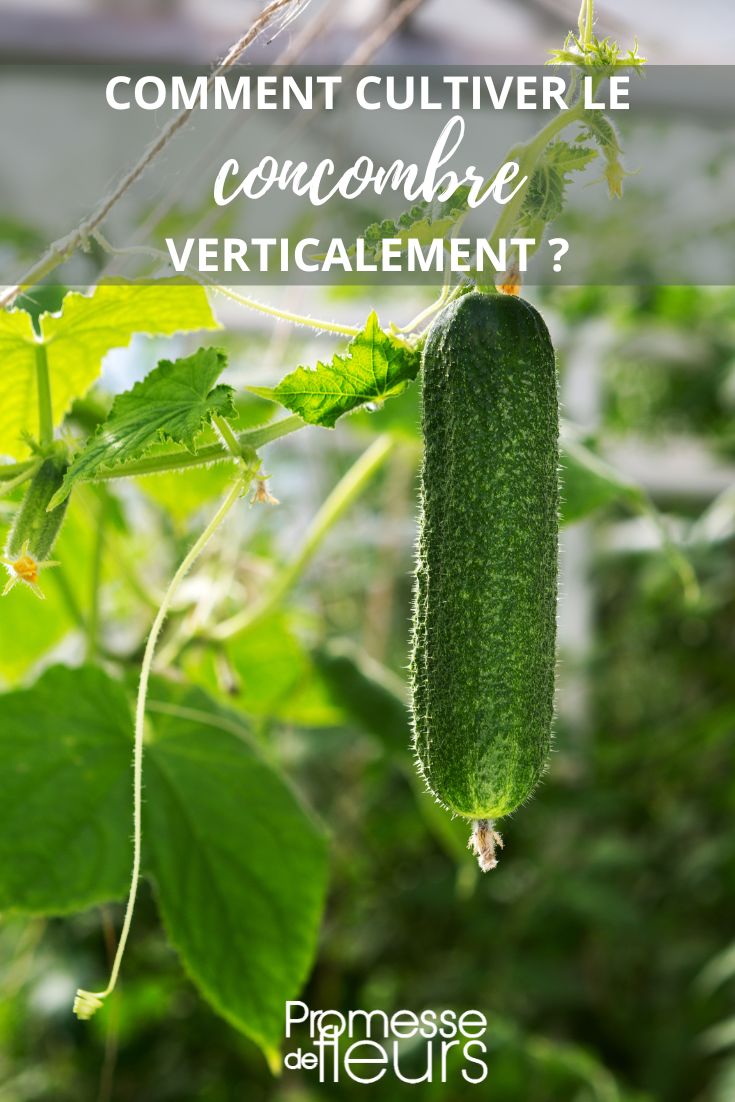
Feedbacks